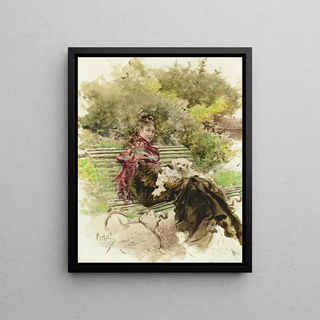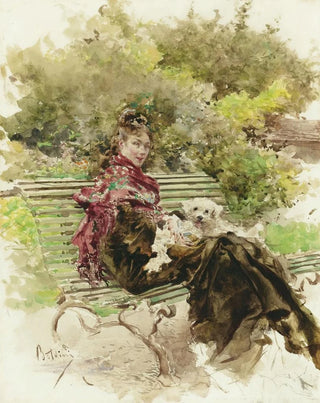Art print | In the park - Giovanni Boldini


View from behind

Frame (optional)
In the enchanting world of art, some artworks manage to capture the very essence of life in a frozen moment. "In the Park - Giovanni Boldini" is one of those creations that evoke an atmosphere of lightness and refinement. Gazing at this piece, the viewer is transported to a lush garden, where the beauty of the characters blends with the surrounding nature. Boldini, master of the portrait, succeeds in transcending the simple frame of painting to offer a sensory experience, where every detail tells a story. The work, both vibrant and delicate, embodies an era when elegance was the watchword, and every moment spent in nature was a celebration of life.
Style and uniqueness of the work
Giovanni Boldini's style is recognizable among a thousand, characterized by a fluid and dynamic touch that gives his subjects a sense of movement. In "In the Park," this fluidity is evident in the light dresses of the women, which seem to dance with the breeze. The colors chosen by the artist, from pastel shades to more vivid hues, create a striking contrast with the lush green of the park, thus enhancing the feeling of joy and vitality. The composition, carefully orchestrated, guides the eye across the painting, inviting the viewer to explore every corner of this lively scene. Boldini skillfully plays with light, capturing reflections and shadows, which gives an unprecedented depth to his work. This ability to marry technique and emotion makes "In the Park" a masterpiece that transcends time.
The artist and his influence
Giovanni Boldini, born in Italy and having found his path in France, is often associated with the Impressionist movement, although he developed his own style, combining elegance and modernity. His career, marked by success, allowed him to mingle with emblematic figures of his era, enriching his art with diverse influences. Boldini was able to capture the spirit of La Belle Époque, a period when glamour and refinement were omnipresent. His work is not limited to portraiture but extends to a true study of

Matte finish

View from behind

Frame (optional)
In the enchanting world of art, some artworks manage to capture the very essence of life in a frozen moment. "In the Park - Giovanni Boldini" is one of those creations that evoke an atmosphere of lightness and refinement. Gazing at this piece, the viewer is transported to a lush garden, where the beauty of the characters blends with the surrounding nature. Boldini, master of the portrait, succeeds in transcending the simple frame of painting to offer a sensory experience, where every detail tells a story. The work, both vibrant and delicate, embodies an era when elegance was the watchword, and every moment spent in nature was a celebration of life.
Style and uniqueness of the work
Giovanni Boldini's style is recognizable among a thousand, characterized by a fluid and dynamic touch that gives his subjects a sense of movement. In "In the Park," this fluidity is evident in the light dresses of the women, which seem to dance with the breeze. The colors chosen by the artist, from pastel shades to more vivid hues, create a striking contrast with the lush green of the park, thus enhancing the feeling of joy and vitality. The composition, carefully orchestrated, guides the eye across the painting, inviting the viewer to explore every corner of this lively scene. Boldini skillfully plays with light, capturing reflections and shadows, which gives an unprecedented depth to his work. This ability to marry technique and emotion makes "In the Park" a masterpiece that transcends time.
The artist and his influence
Giovanni Boldini, born in Italy and having found his path in France, is often associated with the Impressionist movement, although he developed his own style, combining elegance and modernity. His career, marked by success, allowed him to mingle with emblematic figures of his era, enriching his art with diverse influences. Boldini was able to capture the spirit of La Belle Époque, a period when glamour and refinement were omnipresent. His work is not limited to portraiture but extends to a true study of






